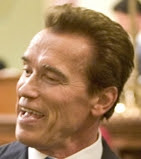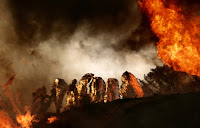California Fire News
California Fire News |  |
| Airport manager overstepped bounds in changing plan Posted: 10 Jan 2008 12:40 AM CST It never should have been in doubt, but CalFire's plans to build a new air-attack base on 12 acres at the Hollister Municipal Airport are once again included in the airport layout plan under review by officials. The reason it had been in question three weeks ago was Airport Manager Bill Gere's inexcusable decision to remove the CalFire base from the plan before it went to the Hollister City Council - just after the airport advisory commission had approved a recommendation to include it. After Gere had done so, the city council delayed an approval to the layout plan so that officials could iron out differences between the document OK'd by the advisory commission and the one that found its way to council members. There are really two issues here. One, Hollister must do everything it can to keep the state's air-attack base local, and a new facility is necessary to achieve that. And two, the airport manager made a poor judgment when he swapped out the advisory commission's inclusion of the air-attack base between the time of the recommendation's approval and the council's consideration of the plan. In doing so, Gere far surpassed his authority as a city staff member, and his actions were counterproductive to the democratic process in place and the very reason advisory panel's are established at every level of government. City officials rightfully delayed the decision while questioning and criticizing Gere's move. Former airport manager and current advisory commission member Allen Ritter called Gere's behavior inappropriate and noted that he, as airport manager, never would have made such a change after an approval. City Manager Clint Quilter was a bit more restrained in his remarks, but did say, "The layout plan presented to the city council was different from the one presented to the airport commission, and that's a problem." It is a problem, not only because it violated part of an established system for making representative decisions, but also because it would set a bad precedent and confuse the process if allowed. Gere defended his actions, downplaying the significance. He acknowledged changing the plan before it got to the council, but called the action "not substantial." He also told Free Lance reporter Anthony Ha that many of the people speaking out against him at a Dec. 17 council meeting were protecting "specific, selfish interests" rather than focusing on welfare of the airport as a whole. We strongly disagree that erasing CalFire from the layout plan was "not substantial." And whether speakers at a public meeting had their own interests in mind while criticizing a public official doesn't matter. That type of dialogue - open, public, for the most part unrestrained - is what makes the democratic process work. Source: HollisterFreelance.com | ||||
| USGS: 2007 California Wildfire Impacts on Wildlife Posted: 10 Jan 2008 12:50 AM CST USGS Scientist Reveals 2007 California Wildfire Impacts on Wildlife The Southern California wildfires in late 2007 impacted more than humans. Wildlife also suffered. Listen to USGS Biologist Robert Fisher describe what USGS scientists discovered about the wildfire impact on wildlife by listening to episode 25 of CoreCast, the USGS podcast. "Certain groups of animals seem to be disproportionately impacted by the fires, such as non-forest salamanders and shrews," said Fisher. "We are not sure whether there is a physical change in the landscape after the fires where these animals do not have enough wet habitats to live in or whether there is a toxic effect of ash that may be directly causing mortality." Scientists are also concerned about the wildfire impact on the landlocked southern steelhead rainbow trout population in the Santa Ana Mountains of Orange County, Calif., because it may be the last genetically pure form of its kind in these mountains. Most other fish populations in this area have been wiped out over the past 20 years due to drought and flood conditions.
"When I was in the Santa Ana Mountains in July, there seemed to be a little more than 100 rainbow trout of all different size classes, scattered in about a quarter of a mile in the canyon, primarily in 10 to 12 pools," said Fisher. "So it really is a restricted area, a restricted population, and any additional stresses in that type of situation are really going to have an impact on them." While examining a post-wildfire burn site, scientists observed extreme dry ravel events - a river of rocks - falling down hillsides and filling up the pools of water where the trout live. If the trout survived the dry ravel, the next impact could be when rain mixes with the dry ravel, and the mixture begins to move. This mixture could fill in the creek systems in the canyon and remove the rest of the water sources, Fisher said. In the podcast, Fisher also describes how scientists captured endangered mountain-yellow legged frog tadpoles before post-fire and drought conditions depleted their population and are housing them until they grow into adults. Scientists want to release the adult frogs into the wild when conditions are suitable. "We are hopeful that the research we are doing - figuring out the indirect and direct effects of wildfire - is going to help us better manage the landscape and build more resilient communities for humans and wildlife," Fisher said. Source: (1) USGS Scientist Reveals 2007 California Wildfire Impacts on Wildlife
| ||||
| USFA Releases Provisional 2007 Firefighter Fatality Statistics Posted: 09 Jan 2008 12:49 PM CST
| ||||
| SAR - Search is still on for missing hiker Posted: 09 Jan 2008 04:49 PM CST | ||||
| Today Is Last Day To Apply For Disaster Assistance Posted: 09 Jan 2008 11:42 AM CST Today is the last day for residents who suffered damages from the Southern California wildfires to register for assistance, Victims in the affected counties of Los Angeles, Orange, Riverside, San Bernardino, Santa Barbara, San Diego and Ventura now have until 6:00 pm January 9, 2008, to apply for federal and state disaster assistance.
There are two ways to begin the application process:
| ||||
| Governor to announce firefighting insurance Fee(Tax) Posted: 09 Jan 2008 02:22 PM CST SACRAMENTO (CAL FIRE NEWS) – Seeking to bolster California's firefighting defenses, Gov. Arnold Schwarzenegger tomorrow will propose a surcharge(Insert Fee, Tax) of roughly $10 per year(?) on property insurance premiums to pay for increased firefighting capacity to battle wild land fires more aggressively. The governor's plan calling this a new "Fee" (Tax) would raise over $125 million a year through a 1.25 percent surcharge on annual homeowner, Plan calls for 1.25% levy on all residential and commercial property, business policies that cover fire, flood, theft and other losses. This $125 million a year "Fee" (Hidden tax) buys the Governor:
"It provides us a surge capacity across the state," said Sheldon Gilbert, chief of the Alameda County Fire Department and president of the California Fire Chiefs Association, who helped shape the proposal. The average small-business and homeowner policy will increase by about $10 a year, or 83 cents a month, administration officials said.(Sure it will...Wanna take bets that this is on the low side?) "It is fair and equitable. Everyone pays. Everyone benefits," Dan Dunmoyer, the governor's deputy chief of staff, said. Dunmoyer, who represented insurers in the Capitol before joining the governor's team, said the average homeowner or small-business policy runs about $900 to $1,000 a year. Insurance industry representatives denied that they were involved in drafting the plan for the 1.25% surcharge. They said they learned about it at a meeting of insurance company executives in the governor's office in mid-December. Under the governor's plan, insurers would collect the surcharge from consumers and distribute it to the state.The charge would be added to an existing 2.35% premium tax on property insurance policies. That tax, which is not earmarked for any particular program, generated $216 million for the state budget in 2006, according to the Department of Insurance. "A surcharge is better than previous attempts to impose parcel taxes on those living in regions protected by state firefighters", he said. Collecting that tax was complicated by difficulties in confirming who should pay, and it became entangled in litigation during previous attempts, Dunmoyer said. Foes say it is a tax that calls for new charges to be tacked onto the insurance bill for every residential and commercial property in the state. Administration officials call the charges fees and defend them as consistent with the governor's pledge, repeated in his State of the State address Tuesday, to not raise taxes. Money in the states general fund already earmarked for fire could be freed up giving the Governor some wiggle room in upcoming 2008 budget. Administration officials acknowledged that some of the money raised could be used to balance the budget. They declined to be precise about how much. "I don't know how you avoid calling it a tax," Lew Uhler, president of the National Tax Limitation Committee, said of the assessment. "The ability of government officials to figure out new ways to tax us is limitless, no matter what their nomenclature." The implementation of a "Fee" versus a "Tax" would be an end run around implementing a "Official Tax" for Republican Governor Schwarzenegger, Who believes this is California's best chance to immediately improve firefighting capabilities in a tight budget year. The state is staring at a budget shortfall of over 14 billion dollars. A few months ago, Schwarzenegger increased California drivers' registration by up to $11 to establish a research fund for alternative fuel development. Others said the plan would not necessarily lead to enhanced fire protection. The net gain in Firefighting response would probably be much less than touted. As the money came in, the governor could cut existing funds from firefighting agencies and use it to help close a budget gap that his office projects at $14 billion, said one consumer advocate, who asked why the burden would fall on property owners instead of insurance companies. "If the governor wants to fill the budget gap, he should find an honest way to do it," said Doug Heller, executive director of the Foundation for Taxpayer and Consumer Rights. "He's wrong to target insurance customers, whose premiums are already too high." Sources: SoSD, LA Times | ||||
| LA Times - Photo essay of Santiago Fire burnover Posted: 09 Jan 2008 11:29 AM CST The LA Times has put together a great photo essay with pictures from a Santiago Fire burnover involving OCFA / CAL FIRE personal deploying fire shelters. Shelter deployment radio traffic along with the photography. The Twelve firefighters trapped by flames atop a ridge off Santiago Canyon Road in Orange County scramble into aluminum fire shelters. The firefighters were examined at the scene by paramedics but refused to go to the hospital. Great photography from Karen Tapia Andersen http://www.latimes. com/la-burnover- f,0,732907. flash?coll= la-home-center |
| You are subscribed to email updates from California Fire News - Structure, Wildland, EMS To stop receiving these emails, you may unsubscribe now. | Email Delivery powered by FeedBurner |
| Inbox too full? | |
| If you prefer to unsubscribe via postal mail, write to: California Fire News - Structure, Wildland, EMS, c/o FeedBurner, 20 W Kinzie, 9th Floor, Chicago IL USA 60610 | |



